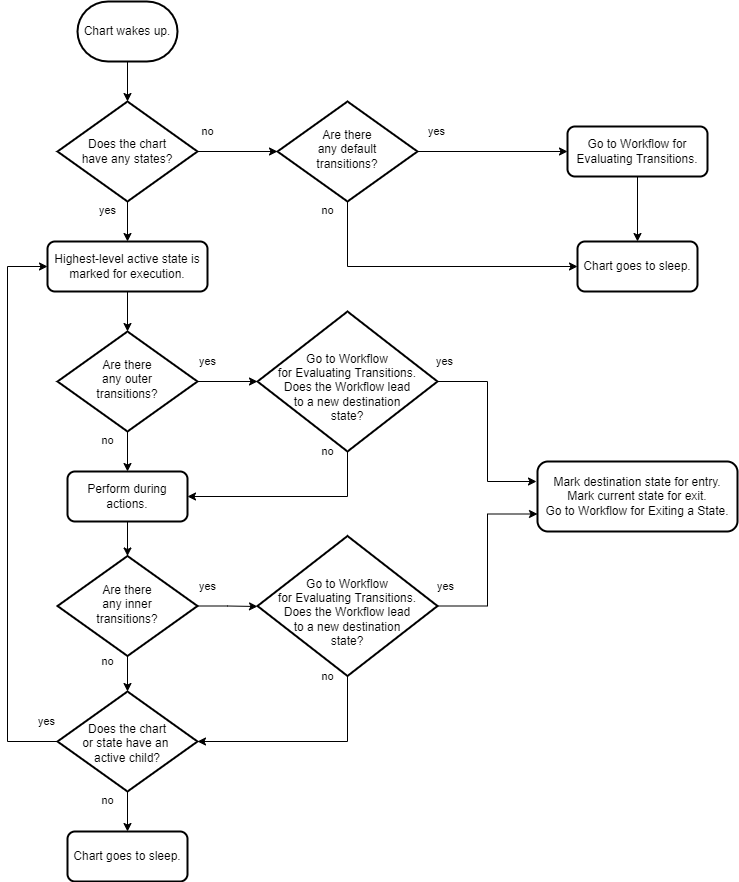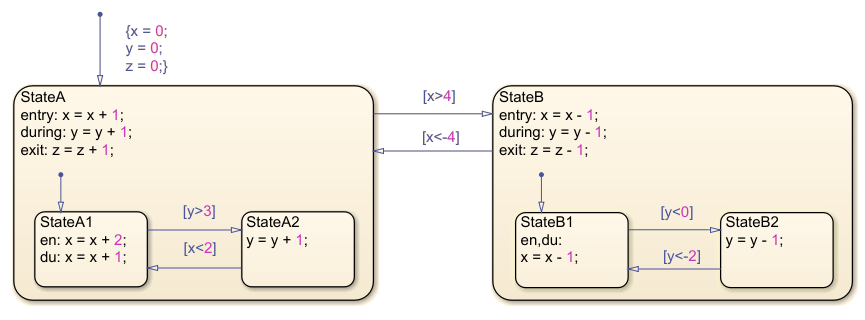Execution of a Stateflow Chart
When a Stateflow® chart wakes up, the chart follows a workflow and executes actions. A Stateflow chart wakes up:
At each time step
When the Stateflow chart receives an event
When a chart wakes up for the first time, the chart is initialized and becomes active, as described in Workflow for Entering a Chart or State. When there are no more actions to take, the chart goes to sleep until a new time step or event wakes up the chart.
Workflow for Stateflow Chart Execution
This flow chart shows the progression of events that Stateflow takes when executing a chart or state. In this flow chart, the current state refers to the state in which a decision or a process takes place.

Default Transitions
A default transition is a transition that has no source. In a Stateflow chart that does not contain any states, a default transition marks the start of a flow chart. For more information, see Create Flow Charts in Stateflow.
If a Stateflow chart does not contain any states, the chart evaluates the default transition paths each time the chart wakes up. After marking a default transition for evaluation, the chart follows the steps shown in Workflow for Evaluating Transitions.
Note
Charts evaluate default transition paths inside a state only during state entry, and not each time the chart wakes up.
Outer Transition
An outer transition is a transition that exits the source state. A Stateflow chart marks outer transitions for evaluation as the first step in executing a state. After marking an outer transition for evaluation, the chart follows the steps shown in Workflow for Evaluating Transitions.
During Actions
A during action is an action defined in a state label actions by
using the prefix during or du. For more
information, see Define Actions in a State.
A state performs during actions when the chart wakes up, the state
is active, and there are no valid outer transitions.
Inner Transitions
An inner transition is a transition that does not exit the source state. For more information, see Control Chart Execution by Using Inner Transitions.
A Stateflow chart marks inner transitions for evaluation after a state performs
during actions. After marking an inner transition for evaluation,
the chart follows the steps shown in Workflow for Evaluating Transitions.
Chart Execution with a Valid Transition
In this example, the Stateflow chart has been initialized and the entry actions have
been performed for StateA and StateA1. A new time
step occurs and the chart wakes up.
At this time step, x = 5, y = 2, and
z = 0.

The chart executes these steps:
The chart has an active substate,
StateA.StateAhas an outer transition toStateB. The chart determines that the transition is valid.The chart marks
StateBfor entry andStateAis marked for exit.To exit
StateA, the chart follows the steps shown in Workflow for Exiting a State.To enter
StateB, the chart follows the steps shown in Workflow for Entering a Chart or State
Chart Execution Without a Valid Transition
In this example, the Stateflow chart has been initialized and the entry actions have
been performed for StateA and StateA1. A new time
step occurs and the chart wakes up.
At this time step, x = 3, y = 0, and
z = 0.

The chart executes these steps:
The chart has an active substate,
StateA.StateAhas an outer transition toStateB. The chart determines that the transition is invalid.The chart performs the
duringactions forStateA. Nowy = 1.StateAdoes not have any inner transitions.The active substate of
StateAisStateA1.StateA1has an outer transition toStateA2. The chart determines that the transition is invalid.The chart performs the
duringactions forStateA1. Nowx = 4.StateA1does not have any active substates.The chart goes to sleep.
